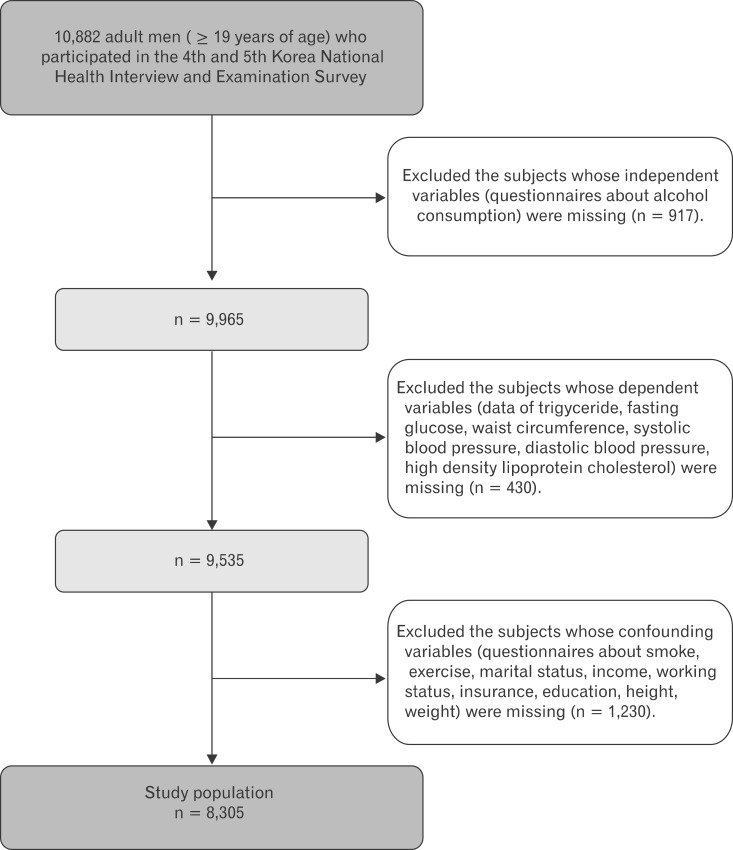 |
 |
- Search
| Korean J Fam Med > Volume 35(4); 2014 > Article |
Abstract
Background
Methods
Results
References
Figure 1

Table 1

Values are presented as mean ± SD or number (%).
*Defined as drinking more than 7 glasses of alcohol at once. †The frequency of binge drinking. ‡Examined the characteristics of participants by t-test (continuous variable) and by chi-square test (categorical variable). §Used the protocol of the Korean version of the International Physical Activity Questionnaire short form to calculate metabolic equivalent of task minutes per week (MET-minutes per week), then classified into 3 groups by tertiles of MET-minutes per week. The 1st group has the lowest MET-minutes per week in average, and the 3rd group has the highest MET-minutes per week in average.
Table 2

Values are presented as number (%) or adjusted odds ratio (95% confidence interval).
*Metabolic syndrome is defined by having 3 or more of the following component: high density lipoprotein cholesterol < 40 mg/dL, fasting plasma glucose ≥ 100 mg/dL or use of hypoglycemic medication, serum triglyceride ≥ 150 mg/dL, blood pressure ≥ 130 (systolic)/85 (diastolic) mm Hg or use of blood pressure medication, and waist circumference ≥ 90 cm (Asia-Pacific region). †Defined as drinking more than 7 glasses of alcohol at once. ‡The frequency of binge drinking. §Statistical analysis by logistic regression with adjustment for age. ∥Adjusted for smoking status, pure alcohol consumed per day, exercise, insurance status, education, working status, marital status, monthly income in addition to model 1. ¶Adjusted for body mass index, in addition to model 2. **0.048.
Table 3

Values are presented as adjusted odds ratio (95% confidence interval).
*Statistical analysis by logistic regression with adjustment for age, smoking status, exercise, insurance status, education, working status, marital status, monthly income. †Metabolic syndrome is defined by having 3 or more of the following component: high density lipoprotein cholesterol < 40 mg/dL, fasting plasma glucose ≥ 100 mg/dL or use of hypoglycemic medication, serum triglyceride ≥ 150 mg/dL, blood pressure ≥ 130 (systolic)/85 (diastolic) mm Hg or use of blood pressure medication, and waist circumference ≥ 90 cm (Asia-Pacific region). ‡Defined as drinking more than 7 glasses of alcohol at once. §The frequency of binge drinking. ∥Grouped by pure alcohol consumed per day into nonconsumer (<1 g/d), light consumer (≥1 g/d, <15 g/d), moderate consumer (≥15 g/d, <30 g/d), heavy consumer (≥30 g/d). ¶Could not calculate the adjusted odds ratio because there were only 2 subjects in the subgroup. And could not calculate because there were only 2 groups in heavy consumer. **0.052.
- TOOLS
-
METRICS

- Related articles in KJFM
-
Association between C-Reactive Protein and Metabolic Syndrome in Korean Adults2019 March;40(2)
Relationship between Metabolic Syndrome and Rheumatoid Arthritis2016 January;37(1)
Association between Metabolic Syndrome and Microalbuminuria in Korean Adults2015 March;36(2)
Dietary Fat Intake and the Risk of Metabolic Syndrome in Korean Adults2015 September;36(5)





